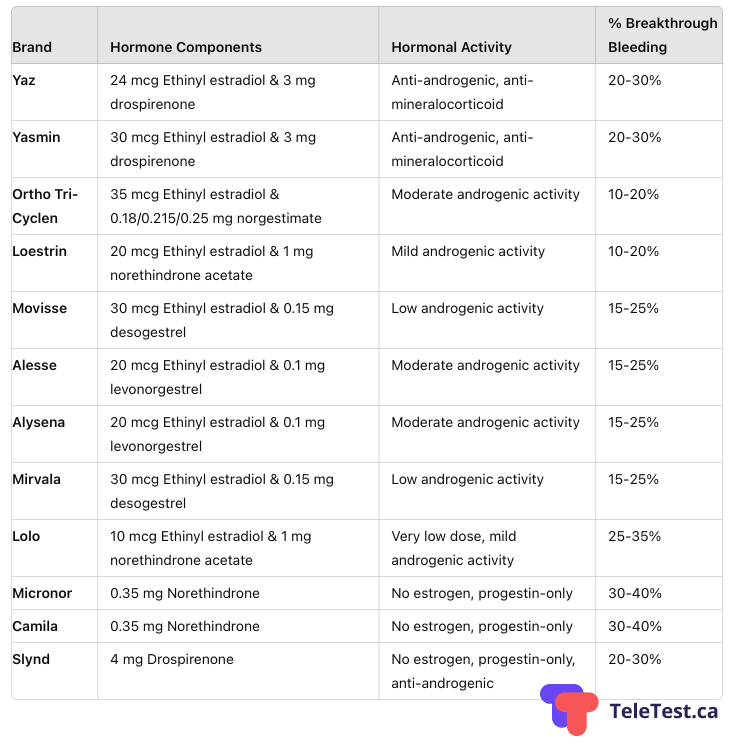Types of Birth Control Pills
Birth control pills, also known as oral contraceptives, are medications taken by mouth to prevent pregnancy. They are categorized into two main types: Combined Oral Contraceptives (COCs) and Progestin-Only Pills (POPs). Each type has its unique composition and works slightly differently to prevent pregnancy.
A. Combined Oral Contraceptives (COCs)
Combined Oral Contraceptives (COCs) contain two hormones: estrogen and progestin. These hormones work together to prevent ovulation, which means they stop the ovaries from releasing eggs. Without an egg, there is nothing for sperm to fertilize, so pregnancy cannot occur. COCs also thicken the mucus in the cervix, making it harder for sperm to enter the uterus, and thin the lining of the uterus, making it less likely for a fertilized egg to implant and grow.
Common examples of COCs include:
- Yaz
- Yasmin
- Ortho Tri-Cyclen
- Loestrin
- Movisse
- Alesse
- Alysena
- Mirvala
- Lolo
B. Progestin-Only Pills (POPs)
Progestin-Only Pills (POPs), sometimes called "mini-pills," contain only one hormone: progestin. They are a good option for women who cannot take estrogen for health reasons, such as those who are breastfeeding or have a higher risk of blood clots. POPs primarily work by thickening the cervical mucus to prevent sperm from reaching an egg. They also thin the lining of the uterus to prevent implantation. In some cases, they can also suppress ovulation.
Common examples of POPs include:
- Micronor
- Camila
- Slynd
Each type of pill has its advantages and disadvantages. COCs are generally more effective at preventing pregnancy and offer additional benefits, such as regulating periods and reducing acne. However, they carry a higher risk of certain side effects, like blood clots, especially in women who smoke or have certain health conditions. POPs are a safer option for some women but must be taken at the same time every day to be effective.
Popular Brands of Combined Oral Contraceptives (COCs)
Combined Oral Contraceptives (COCs) contain both estrogen and progestin. These hormones work together to prevent pregnancy and can also offer additional benefits like reducing acne and regulating menstrual cycles. Here, we will explore some popular brands of COCs, their compositions, benefits, and potential side effects.
Yaz
- Composition: Ethinyl estradiol and drospirenone
- Benefits: Yaz is known for helping with acne and providing lighter, more manageable periods. It can also help with premenstrual dysphoric disorder (PMDD), a severe form of premenstrual syndrome (PMS).
- Potential Side Effects: Some women may experience nausea, headache, breast tenderness, and an increased risk of blood clots.
Yasmin
- Composition: Ethinyl estradiol and drospirenone
- Benefits: Yasmin helps reduce water retention, which can decrease bloating. It also helps stabilize mood swings and improve skin conditions like acne.
- Potential Side Effects: Possible side effects include nausea, breast tenderness, headache, and a higher risk of blood clots.
Ortho Tri-Cyclen
- Composition: Ethinyl estradiol and norgestimate
- Benefits: Ortho Tri-Cyclen is effective at controlling acne and has a three-phase dosage that mimics the natural menstrual cycle.
- Potential Side Effects: Side effects can include nausea, headache, breast tenderness, and mood changes.
Loestrin
- Composition: Ethinyl estradiol and norethindrone acetate
- Benefits: Loestrin has a lower hormone dose, which can reduce the likelihood of side effects. It also offers shorter, lighter periods.
- Potential Side Effects: Some women may experience breakthrough bleeding, nausea, and breast tenderness.
Movisse
- Composition: Ethinyl estradiol and desogestrel
- Benefits: Movisse is reliable for cycle control and can help with acne management.
- Potential Side Effects: Common side effects include nausea, headache, and breast tenderness. There may also be an increased risk of blood clots.
Alesse
- Composition: Ethinyl estradiol and levonorgestrel
- Benefits: Alesse is a low-dose option that is generally well-tolerated and effective at preventing pregnancy.
- Potential Side Effects: Possible side effects include nausea, headache, and breast tenderness.
Alysena
- Composition: Ethinyl estradiol and levonorgestrel
- Benefits: Alysena is a generic option, making it more cost-effective. It provides reliable pregnancy prevention and cycle control.
- Potential Side Effects: Side effects can include nausea, headache, and breast tenderness.
Mirvala
- Composition: Ethinyl estradiol and desogestrel
- Benefits: Mirvala helps regulate the menstrual cycle and can improve acne.
- Potential Side Effects: Common side effects include nausea, headache, and breast tenderness, with a possible increased risk of blood clots.
Lolo
- Composition: Ethinyl estradiol and norethindrone acetate
- Benefits: Lolo has a very low hormone dose, which can result in fewer side effects. It also helps manage menstrual cycles and reduce period pain.
- Potential Side Effects: Side effects may include breakthrough bleeding, nausea, and breast tenderness.
Popular Brands of Progestin-Only Pills (POPs)
Progestin-Only Pills (POPs), also known as "mini-pills," contain only the hormone progestin. These pills are ideal for women who cannot take estrogen and are particularly suitable for breastfeeding women and those at risk of blood clots. Let's take a closer look at some popular brands of POPs, their compositions, benefits, and potential side effects.
Micronor
- Composition: Norethindrone
- Benefits: Micronor is a good option for breastfeeding women because it does not affect milk production. It effectively prevents pregnancy by thickening the cervical mucus and thinning the uterine lining.
- Potential Side Effects: Some women may experience irregular menstrual cycles, spotting between periods, and changes in mood.
Camila
- Composition: Norethindrone
- Benefits: Camila is similar to Micronor and is also a suitable choice for breastfeeding women. It reduces the risk of blood clots, making it a safer option for women with certain health risks.
- Potential Side Effects: Common side effects include irregular periods, spotting, and mood swings.
Slynd
- Composition: Drospirenone
- Benefits: Slynd offers a unique advantage with a 24-hour missed pill window, meaning it is more forgiving if you forget to take a pill on time. It also helps reduce acne and can be taken continuously without a break.
- Potential Side Effects: Possible side effects include nausea, headache, breast tenderness, and irregular bleeding.
Key Differences and Similarities Among POPs
- Effectiveness: All POPs are effective at preventing pregnancy when taken correctly. However, they must be taken at the same time every day to maintain their effectiveness.
- Side Effects: Common side effects of POPs include irregular menstrual cycles, spotting, and mood changes. These side effects are generally less severe than those associated with COCs.
- Health Benefits: POPs are particularly beneficial for women who are breastfeeding or those who have an increased risk of blood clots. They also do not contain estrogen, making them a safer option for some women.
- Missed Pill Window: Slynd stands out for its 24-hour missed pill window, offering more flexibility compared to other POPs that require strict adherence to the dosing schedule.
Key Factors for Comparison
When comparing different birth control pills, it is essential to consider several key factors. These factors help determine which pill may be the best fit for an individual's health needs and lifestyle preferences.

A. Effectiveness
- Definition: Effectiveness refers to how well the pill prevents pregnancy when taken correctly.
- Comparison: Most birth control pills, whether COCs or POPs, are over 99% effective when taken as directed. However, the effectiveness can drop to around 91% with typical use due to missed pills or incorrect usage.
B. Hormone Levels
- Definition: Hormone levels refer to the amount of estrogen and progestin in the pill.
- Comparison: Pills with lower hormone levels, such as Lolo, tend to have fewer side effects but may cause more breakthrough bleeding. Higher hormone levels can provide better cycle control but may increase the risk of side effects like nausea and headaches.
C. Side Effects
- Definition: Side effects are unwanted symptoms caused by the medication.
- Comparison: Common side effects of birth control pills include nausea, headache, breast tenderness, and mood changes. Some pills may have unique side effects, such as the increased risk of blood clots with COCs containing drospirenone (e.g., Yaz, Yasmin). Progestin-only pills (POPs) often cause irregular periods and spotting.
D. Additional Health Benefits
- Definition: Additional health benefits are positive effects of the pill beyond pregnancy prevention.
- Comparison: Some pills, like Yaz and Ortho Tri-Cyclen, help with acne control. Others, like Loestrin and Lolo, offer lighter and shorter periods. Pills containing drospirenone can reduce water retention and bloating.
E. Cost and Insurance Coverage
- Definition: Cost refers to the price of the medication, while insurance coverage indicates whether the cost is covered by health insurance.
- Comparison: If you’re under 25, provincial insurances such as OHIP in Ontario, Canada may cover the cost of medication. Otherwise, generic options like Alysena are typically more cost-effective than brand-name pills. Private insurance plans such as those offered by employers may cover different brands and types of birth control, so checking coverage is essential to minimize out-of-pocket expenses.
Personal Considerations
Each woman’s body responds differently to birth control pills. Therefore, it is crucial to consider personal health conditions and lifestyle factors when choosing a pill:
Health Conditions
- High Blood Pressure: Women with high blood pressure should avoid pills with high estrogen levels, as they can increase blood pressure further.
- Migraines: Women with migraines, especially with aura, should be cautious with estrogen-containing pills, as they can trigger more severe migraines.
- History of Blood Clots: Women with a history of blood clots or clotting disorders should opt for progestin-only pills to minimize the risk.
Lifestyle Factors
- Smoking: Smoking increases the risk of blood clots, especially in women over 35. Progestin-only pills are safer for smokers.
- Breastfeeding: Progestin-only pills are recommended for breastfeeding women because they do not affect milk production.
- Weight Considerations: Some studies suggest that birth control pills may be less effective in women with higher body weights, so consulting a healthcare provider is essential for personalized advice.
Importance of Consulting with Healthcare Provider
While this guide provides valuable information about various birth control pills, consulting with a healthcare provider is essential. For those in Canada, TeleTest offers all the major brands of hormonal birth control, one of our healthcare providers can offer personalized advice based on medical history, current health status, and individual needs. They can help navigate the complexities of birth control options and ensure that the chosen method is safe, effective, and aligns with personal health goals.
Personalizing Birth Control Choices
Every woman is different, and what works well for one person might not be suitable for another. Personalizing birth control choices involves considering all the factors discussed and having an open conversation with a healthcare provider. This collaborative approach ensures that the chosen method not only prevents pregnancy effectively but also supports overall health and well-being.
Beyond Hormonal Pills
It's also important to remember that hormonal pills are just one of many options for birth control. Other methods include intrauterine devices (IUDs), contraceptive implants, injections, patches, vaginal rings, barrier methods like condoms and diaphragms, and natural family planning methods. Each method has its own set of advantages and considerations, making it crucial to explore all options to find the best fit for your needs.
Choosing the right birth control method involves understanding the types available, evaluating popular brands, considering key factors, and addressing special health and lifestyle considerations. By making an informed decision with the guidance of a healthcare provider, women can find the birth control method that best fits their unique needs and enhances their quality of life.
Disclaimer: This blog post is intended for educational purposes only and should not be taken as medical advice. Always consult your healthcare provider for personal health concerns.
